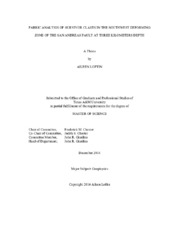| dc.description.abstract | The mechanisms responsible for aseismic creep along the central section of the San Andreas Fault are not well understood. Evidence for both pressure- and chemical-dependent microprocesses of creep have been reported. Here, the kinematics and deformation mechanisms of the Southwest Deforming Zone (SDZ) of the San Andreas Fault are investigated through fabric analysis of survivor clasts recovered from ~2.6 km depth by coring at the San Andreas Fault Observatory at Depth (SAFOD). The size-frequency and shape-size distributions of survivor clasts from the SDZ were characterized through 3D analysis of X-Ray Computed Tomography (XCT) images of SDZ core samples. A number of processing techniques were employed to calibrate, remove artifacts, filter and threshold the XCT images and distinguish survivor clasts so as to enable 3D rendering of clasts for size and shape analysis. The size of clasts fit a power-law probability distribution function with a negative exponent (scaling parameter) of 3 over the range of 0.45 mm to 60 mm in diameter. Using best-fit primitive ellipsoids and clast volume as reference, clast shapes are characterized as oblate spheroids, moderate (1.5-2.5) aspect ratio with high convexity and sphericity (>0.6); the shape distributions appear invariant with clast size.
The size and shape characteristics, and the uniform spatial distribution of survivor clasts within the SDZ, suggest that the zone has attained a mature, quasi steady-state condition. The scaling parameter of 3 supports that the reduction in the size of clasts is a result of fracture consistent with a nearest neighbor fragmentation model for high strain, matrix-dominated shear zones. However, clast shape distributions support that surface wear, such as by abrasion or pressure solution, are the dominant clast shaping process. | en |


